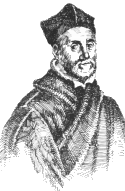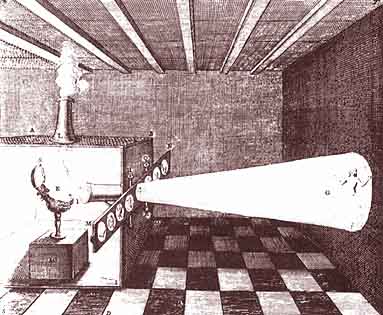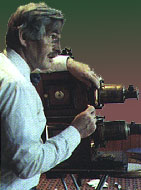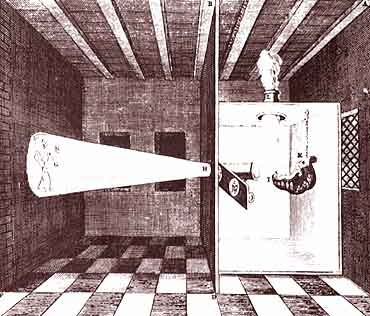|
THE MYSTERY OF THE WRONGLY PLACED LENSES or IS ATHANASIUS REALLY THE INVENTOR? |
|
 |
Many authors of standard works concerning the invention of the magic lantern, like C.W. Ceram, T.C. Hepworth and Olive Cook, designate Athanasius Kircher as the inventor. They all base their pronouncements on the evidence of Kirchers book "Ars Magna lucis et umbrae" ( The great science of light and dark) first published in Rome, 1646. The two drawings which are supposed to prove Kircher’s inventorship show a light source, translucent slide and a lens, the three ingredients of what could be a magic lantern. However there’s something wrong with the drawings: the arrangement of the components is very unusual. The lens is situated between the light source and the slide, and the slide is wrongly positioned, in other words upright while the image is upright too. Was it possible that Kircher made such a stupid mistake? In his book he describes the arrangement as follows: |
| (In Latin:) "Fiat ex ligno receptaculum A.B.C.D. deinde in L. caminus, ut lucerna per illum fumum suum emittere possit, Lucerna verò K. in medio ponatur vel affixa filo ferreo vel supra fulcrum M. è regione foraminis H., intra quod tubus palmaris committaretur, in tubi verò principio I. lenticulare vitrum melioris notae inferatur in foramine verò, seu in fine tubi H vitrum planum probè elaboratum ponatur, in quo coloribus aqueis & diaphanis quidquid volueris pingatur." | (In English)
"Make a wooden box ABCD, with a chimney at L, such that the lamp can emit its smoke
through it; the light K itself should be placed in the middle of the box, either hanging
on a chain or placed on a pedestal, in a straight line with the aperture H in which a good
tube is mounted. At the very beginning I of the tube a lens of good quality is mounted, in
the aperture or rather the end H of the tube a well-finished flat glass is placed, on
which is painted whatever you want, with translucent
watercolours." This description is
consistent with the situation on the drawings, but also fits with the arrangement as it
ought to be. The problem is that Kircher did not precisely mention where the tube should
be mounted, inside or outside the box. His original Latin text could be interpreted in two
ways. If the words ‘intra quod’ refer to ‘receptaculum’ the
description and engravings are similar; however if they refer to ‘foraminis H’
the text might describe the correct arrangement. This description is
consistent with the situation on the drawings, but also fits with the arrangement as it
ought to be. The problem is that Kircher did not precisely mention where the tube should
be mounted, inside or outside the box. His original Latin text could be interpreted in two
ways. If the words ‘intra quod’ refer to ‘receptaculum’ the
description and engravings are similar; however if they refer to ‘foraminis H’
the text might describe the correct arrangement.Further on Kirchner writes: "In this manner, the light of the lamp, passing through the lens, will display the image painted on the glass plate in H. (which is to be inserted upside down) on the white wall of the room VTSX, upright and magnified, coloured, as drawn from life." The words between the brackets prove that Kirchner positively knew how to put a slide into a projector. There are more annoying errors in the engravings. Some letters don't match the letters in the description. The most striking error is the concave reflector, which is missing on one drawing and placed too high in the second. All these facts make it probable that it was the engraver who was in error, but how could it happen that Kircher did not correct the drawings before they were printed? |
Source: 'The
true inventor of the magic lantern: Kircher, Walgenstein or Huygens?' by W.A. Wagenaar, published in JANUS, Revue internationale de l'histoire des sciences, de la médecine, de la pharmacie et de la technique, 1979. |
The Dutch magic
lantern authority Willem A. Wagenaar gives an explanation in his article ‘The true
inventor of the magic lantern’: "Neither the two engravings, nor the verbal
description of the magic lantern appeared in the first
 edition
of ‘Ars Magna’, but are taken from the second edition which was printed in
Amsterdam, 1671. The engravings were specially made for the second edition, and the
question is: where? It is most likely that a Dutch engraver prepared the new
illustrations; Kircher probably made some sketches, which the Dutch publisher did not like.
….. Therefore the publisher may have decided to replace Kircher’s sketches
(which are rather unattractive throughout the book) by two large elaborate engravings.
……. Another possibility is of course that somewhere between Rome and Amsterdam
Kircher’s sketches got lost; then the engraver was thrown upon the written
description which, as we have seen, was quite ambiguous. However it may be, it is most
likely that the two engravings were made in Holland and published before Kircher could see
them. So Kircher was trapped by his own thrift: Dutch publishers paid for manuscripts,
whereas publishers of many other nationalities wanted to be paid by the authors." edition
of ‘Ars Magna’, but are taken from the second edition which was printed in
Amsterdam, 1671. The engravings were specially made for the second edition, and the
question is: where? It is most likely that a Dutch engraver prepared the new
illustrations; Kircher probably made some sketches, which the Dutch publisher did not like.
….. Therefore the publisher may have decided to replace Kircher’s sketches
(which are rather unattractive throughout the book) by two large elaborate engravings.
……. Another possibility is of course that somewhere between Rome and Amsterdam
Kircher’s sketches got lost; then the engraver was thrown upon the written
description which, as we have seen, was quite ambiguous. However it may be, it is most
likely that the two engravings were made in Holland and published before Kircher could see
them. So Kircher was trapped by his own thrift: Dutch publishers paid for manuscripts,
whereas publishers of many other nationalities wanted to be paid by the authors."
But why didn't Kircher ever protest against the errors made by the publisher? Other researchers, like Joannes Zahn in 1680, did actually criticise Kircher’s arrangement. However, in a summary of Kircher’s work, published by his student Kestler , the same figures are printed with the same text. Assuming that the two figures were made without Kircher’s approval, why did the engraver get the idea to place the slide upright despite the explicit instructions? Wagenaar did some experiments and recognized indeed that images can be projected when arranged as the two pictures show. If the lens has a very short focal distance an image of the light source will appear behind the lens which could be used as a point-light source to project the slide without the use of any further lens. In such an arrangement slides must be placed upright and not upside down. So the drawings could be consistent with Kirchers intentions. Knowing this makes it highly debatable whether Kircher can be considered the true inventor of the magic lantern. This assumption is based on the first edition of ‘Ars Magna’ in 1646, but here we find nothing on projecting lanterns. Nothing points to an arrangement with light, slide and projecting lens, in that order. The second edition of his work in 1671 shows only the strange arrangement as mentioned above, and at that time other scientists like the Dane Thomas Walgenstein and the Dutch Christiaan Huygens had already described the familiar magic lantern several times . |
| |
©1997-2021 'de Luikerwaal' All rights reserved. Last update: 17-05-2021. |